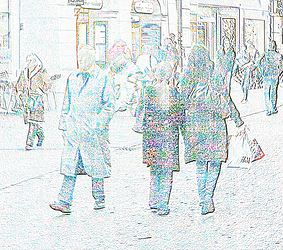My workflow has always been to import my RAW files into Lightroom Classic and then use Photoshop and/or several plugins (Topaz Sharpen or DeNoise). I depend on Lightroom for my photo management and prefer to keep using it. For the most part, I’m happy with the results I’m getting with doing 90%+ of my post-processing with Lightroom Classic. I don’t do a lot of portraits, so skin tones aren’t a huge concern but there’s the occasional one here and again. I do street/urban, landscape, nature. Some of it is converted to B&W.
I’ve been using this workflow for a long time, starting with my Canon EOS 7D, then 5D MkIII, then EOS R, and now my R5. Adobe provided camera-specific color profiles for all those older cameras. Not the R5.
After hearing all the complaints about the R5 colors in Lightroom and the lack of camera-specific profiles, I purchase the R5 profiles from Color Fidelity. Overall, I’m pretty happy with their camera profiles for the R5.
So far, I haven’t taken a lot of low light / super high ISO shots but I probably will eventually. Many people have complained about the excessive noise in these images due to Adobe’s RAW processing of Canon’s CR3 files. Some have reported better results (less noise, better colors, etc.) when using DxO PureRAW to process the RAWs from the R5.
I decided to download the trial for DxO PureRAW and compare it with Lightroom/ColorFidelity/Topaz DeNoise. I have a basic question about how to incorporate DxO PureRAW into my workflow. I know there are several ways to integrate PureRAW with LR but not sure which is best.
After transferring my R5’s CR3 to my computer, I open them in DxO PureRAW. The first time I did this, the program prompted me to download the modules for the camera/lens combo, which I did. I then process them using the default settings (DeepPRIME, DNG). The difference between the original CR3 and the processed DNG is very subtle. It doesn’t look like PureRAW is adjusting colors, except the processed image is a tad more exposed (maybe 1/3 stop). The most obvious difference is the lens correction.
I then import the PureRAW DNG files into Lightroom Classic and follow my normal LR workflow. I select an image and click on the ‘Develop’ module.
First, I apply lens correction. By default both 'remove chromatic aberration and ‘enable profile corrections’ are checked. Since PureRAW already applied lens correction, shouldn’t this be unchecked? Will leaving them checked in LR apply lens correction twice? I unchecked lens correction assuming it was already applied in PureRAW.
Next, I move on to the ‘basic’ section and start with the color profile. PureRAW didn’t do anything here, so I’m not sure why some claimed better colors when using it. In my case, I apply one of my color fidelity camera profiles. One of the last things I do is apply sharpening and noise reduction. I notice that the sharpening slider for these processed DNGs is all the way to the left instead of the default LR settings of 40. From what I understand, PureRAW applies sharpening, so it makes sense that the slider in LR would be set to 0. I’ve read many complaints about over-sharpening in this forum. Does anyone know if DxO is going to let us have more control of this? In the case of this image from my R5, it doesn’t look to be too bad. I certainly don’t need to add any sharpening in LR.
Using LR’s reference view, I can compare the PureRAW DNG to the original CR3. Right away, I can see that the processed DNG is darker. I wonder why the slide viewer in DxO PureRAW showed the opposite…? The lens correction seems to match when the checkboxes are OFF on the DNG and on with the CR3. After matching the color profiles, the colors look almost identical. I adjust the exposure to -0.5 on the CR3 and it is very close. Increasing the texture to +10 for the CR3 makes it almost impossible to see any difference. BTW, it doesn’t help that I only have a 17.3" display. However, it is 100% AdobeRGB and 4K. I leave the sharpening for the CR3 at the default of 40. I don’t need to apply any noise reduction because I can’t find any noise when I zoom into the shadows. It’s a very clean image.
In conclusion-
I’m a little confused by the lens correction. Why isn’t it unchecked for the DNG? If the DNG can be tagged so the sharpening slider is set to 0, why can’t it be tagged to indicate lens correction has been applied?
I still don’t understand the claims about better colors from PureRAW. As far as I can tell they are the same. Am I missing something here?
As for noise reduction (PureRAW/DeepPRIMEs claim to fame), I’ll need to do further testing.
I’d appreciate any advice and thanks for taking the time to read my long post.
7/12/21 update: I’ve had a chance to test a few RAW files that had a lot of noise. These were taken years ago with my older Canon 7D and 5DMIII DSLRs. I think PureRAW did a much better job. I also compared PureRAW to Topaz Denoise AI. It’s close but it takes a lot of tweaking with Denoise to get it to match PureRAW. I’ve got mixed feelings about the comparison - softness, loss of detail, etc.
